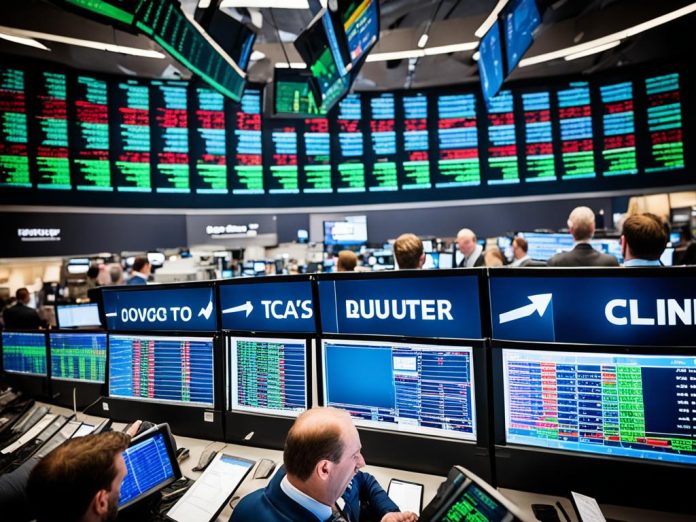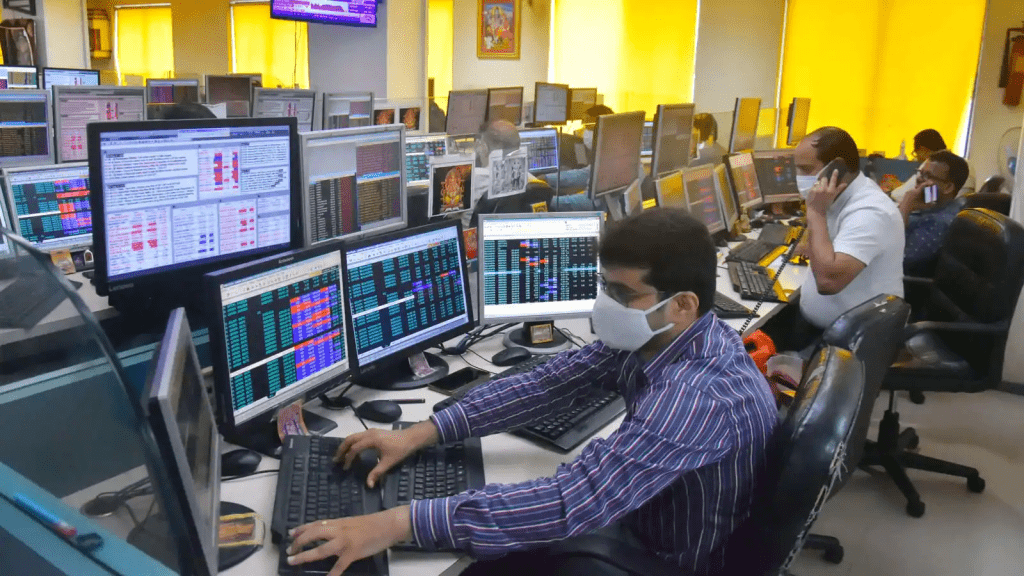Online stock trading is both thrilling and rewarding. Many newbies jump into the stock market to score big. But, they often find themselves losing money. This is because they lack the necessary knowledge about stock markets and their complexities. This guide is here to help. It covers essential trading strategies, platforms, and how to manage risks. It aims to equip readers with the tools to make smart investment choices and possibly boost their profits.
Show the chaos and excitement of a busy stock market floor, with traders frantically buying and selling stocks as the digital ticker tape displays constantly changing numbers. Highlight the fast-paced and risky nature of online trading by incorporating images of computer screens and graphs displaying fluctuating stock prices.
Key Takeaways
- Understanding the primary and secondary markets is crucial for traders and investors.
- Intraday trading means buying and selling shares on the same day. This can lead to profits or losses.
- Before you can start trading, you need to open a demat account.
- Most beginners in online trading face more losses than gains. They struggle because they don’t know the basics and the fine details.
- Keeping a stable emotional state is key to doing well financially.
Understanding the Stock Market
The stock market lets investors trade things like stocks and bonds. It has two key parts: the primary market and the secondary market.
Primary Market
Companies sell new stocks or bonds here first. This happens in an initial public offering (IPO). It gives companies money for big projects or growth.
Secondary Market
The secondary market is where already sold stocks or bonds are traded. Investors can buy or sell their shares here without the company’s direct involvement. They can act based on their own plans and the market’s changes.
Intraday Trading
Some investors practice intraday trading by buying and selling stocks in the same day. It requires knowing a lot about the market, analyzing data, and handling risks well. This can lead to earning money from short-term stock price changes.
Knowing about the markets and intraday trading is key for new investors. It helps them find their way and helps in making smart choices.
Create an image that visualizes the stock market, with different colored lines, bars and curves depicting the trends and movements of various stocks. The image should have a sense of dynamism and energy, with abstract shapes and patterns representing market fluctuations and shifts. The overall impression should be one of both complexity and possibility, as though the market is a vast web of interconnected pieces, waiting to be navigated and explored.
Getting Started with Online Trading
To start with online trading, you need to open a demat and trading account. Think of a demat account as a place for your digital securities. And a trading account allows you to trade stocks on the stock exchange.
Opening a Demat and Trading Account
Setting up these accounts takes less than 15 minutes. Some trusted brokers, like Bajaj Financial Securities Limited, offer them for free. Plus, there are no initial or yearly charges for the first year. This is perfect for new traders who want to start online trading setup without big costs.
For a trading account, you’ll share personal details and pick an account type. You might choose from an individual taxable account, a joint account, or an individual retirement account. They might ask about your job, income, assets, and trading know-how.
After setting up your account, you can add money using bank transfers, wires, or checks. Remember to check the broker’s rules on minimum balances and fees.
Understanding Stock Quotes
A key thing in online trading is stock quotes. They show a stock’s current price. Quotes include the bid and ask prices. These tell us the highest buyer price and the lowest seller price.
Understanding these quotes helps traders make smarter choices. They can know more about a stock’s value and when to buy or sell.
stock market, trading: Fundamental and Technical Analysis
There are two main ways to look at stocks: fundamental and technical analysis. Fundamental analysis checks a company’s finances, growth chances, and trends in its industry. It tries to find the real worth of a stock. It looks at deep economic issues and smaller company details. Important things it considers are how good the management is, any special assets the company has, its competitive position, and its ties to the community.
Fundamental Analysis
Fundamental analysis helps you really get a company’s financial standing. It looks at how important changes, like central bank interest rates, might affect a stock’s value. For example, if the rates go up, stock prices usually drop. This kind of study can take a lot of time and guessing. The guessing comes from trying to judge what different facts really mean.
Technical Analysis
Technical analysis just looks at a stock’s price and the patterns it makes over time. The idea is to predict the future using this history. It guesses that everything important about the stock is already known from its past prices. So, instead of understanding the company, it tries to guess what will happen next by looking at trends.
To do all this, technical analysts use things like charts, looking for certain shapes the price movements make, and lines on the charts that show when prices might change direction. They use a measure called “relative strength” to see if an asset is doing better or worse than a standard. Some experts also check moving averages to decide when to start or stop trading a particular stock.
They also look at different industry groups to see which ones are going up or down. But, betting against a stock (short selling) is tricky and can be very risky. Tools exist to help find good stocks more easily.
However, this method ignores some important things like the company’s true strength or its future plans. People usually use technical analysis for short-term decisions. Fundamental analysis is more about looking at the company’s lasting value.
Many investors use both approaches. This way, they try to cover their bases. The signals to buy or sell are very different between the two. For example, technical analysis focuses on recent trends and prices, while fundamental analysis tries to find stocks that are priced too high or too low.
Long-term plans often use fundamental analysis. But it’s good to mix both ways to get a full view. Together, they can help make smarter investment choices. Keeping up with the market news is key. It helps you use both methods in the right way, whether you’re looking at long or short-term investments.
A graph with two lines, one depicting stock prices and the other one showing trading volume. A magnifying glass positioned over the graph emphasizing a specific time frame, with various arrows pointing to specific points on the graph. A stack of financial reports and documents in the background. The overall color scheme is blue and green representing growth and stability.
Risk Management Strategies
Getting into the stock market means facing risks. For newbies, using smart methods to manage these risks is key. A good approach is to use stop-loss orders. These sell your stock at a set price to avoid big losses. The one-percent rule advises not putting over 1% of your money on a single trade. This helps keep your risks in check.
Setting Stop Loss Orders
Stop-loss and take-profit points are vital for traders to plan. They often use moving averages to do this. For example, the 5-, 9-, 20-, 50-, 100-, and 200-day averages are popular. It’s a methodical way to handle risk. Putting in stop-loss orders can prevent large losses.
Diversifying Your Portfolio
Having a mix of stocks, sectors, and assets is also a good strategy. It cushions you against market swings. Spreading investments in different areas reduces overall risk and boosts chances of gains. Diversifying means not putting all your eggs in one basket. It’s about owning different, unrelated assets to lower total risk without losing out on expected wins.
Figuring out potential trade gains means looking at the odds of winning or losing. Downside put options help protect your money if a trade goes wrong. Active traders work on short-term market changes, not long-term growth. For them, key risk strategies include choosing the best broker, using stop-loss and take-profit points, having a diverse investment mix, and doing hedge positions.
Traders often say, don’t risk more than 1% of your total portfolio on one trade. A 10% account drop can be fixed with an 11.1% win. This makes it important to keep cool when trading. Handling your feelings well is a big part of being a successful trader.
An image of a hand holding a map with a compass and a magnifying glass, signifying the importance of researching and navigating through the stock market before making any investment decisions. The hand is also wearing a protective glove, representing the idea of taking cautious steps in managing risks while trading online.
The Indian stock market is perfect for long-term investors with a diverse portfolio. Yes, every investment comes with risks. But, India’s growing economy and steady financial setup pull in those looking to broaden their financial spread. With online trading basics, deep market research, and smart risk control, even beginners can find their way in the stock market. They might just reach their financial dreams.
India’s stock market is alive with activity. The Bombay Stock Exchange (BSE) is Asia’s most seasoned. Meanwhile, the National Stock Exchange (NSE) drives tech changes. Setting up a trading account with trusted brokers like Religare opens this world to you. Also, investing in dividend stocks offers a steady income. Plus, the S&P BSE Sensex and NSE Nifty indices are go-to markers for market health. They help investors check how well their investments do against the overall market.
Whether you’re seasoned or a newbie, the Indian stock market has much to offer. Using trusted brokers, doing deep research, and managing risks well are keys to success. They can help you thrive in the fast-changing stock market world.
FAQ
What are the main segments of the stock market?
The stock market has two main parts: the primary and secondary markets. The primary market is where new securities are first offered to the public by companies. The secondary market is for buying and selling these securities after they’ve been issued.
What is intraday trading?
Intraday trading means buying and selling stocks within a single day. It’s a strategy done in the secondary market.
What are the steps to start online trading?
The first step to online trading is opening a demat and trading account. A demat account holds your securities, like a bank account. A trading account lets you trade stocks.
How can investors analyze stocks?
Investors analyze stocks using fundamental or technical analysis. Fundamental looks at a company’s finances and future. Technical analysis studies stock price and volume trends to predict the future.
What are some effective risk management strategies?
One good way to manage risk is by using stop-loss orders. This sells a stock if its price hits a certain level. Also, spreading your investments across different stocks and sectors can lower risks.
What are the benefits of investing in the Indian stock market?
India’s growing economy and financial stability make its stock market appealing. Learning online trading basics and taking risks wisely can lead to financial success in the market.









